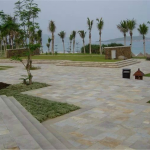Introduction
In recent years, industrial cultured stone has gained popularity as a versatile and cost-effective building material that replicates the look and feel of natural stone. This innovative product has revolutionized the construction industry by offering a wide range of design options, superior durability, and easy installation. In this article, we will delve into the production process of industrial cultured stone, explore its numerous benefits, and examine its applications in various construction projects.
Production Process
Industrial cultured stone is typically made from a mixture of cement, aggregates, and iron oxide pigments to mimic the appearance of natural stone. The production process involves several key steps:
1. Mixing: The raw materials are carefully measured and mixed in precise proportions to achieve the desired texture and color of the final product.
2. Molding: The mixed material is poured into molds that are designed to replicate the shape and texture of natural stone. These molds can vary in size and complexity, allowing for a wide range of design options.
3. Curing: Slate stepping stones for timeless elegance molded pieces are left to cure and harden in a controlled environment for a specific period of time. This process ensures that the cultured stone achieves the necessary strength and durability.
4. Finishing: Once cured, the cultured stone pieces are removed from the molds and undergo additional finishing processes such as sanding, cutting, and sealing to enhance their appearance and durability.

5. Quality Control: Throughout the production process, strict quality control measures are implemented to ensure that the final product meets industry standards for strength, durability, and aesthetics.
Benefits of Industrial Cultured Stone
Industrial cultured stone offers a multitude of benefits that make it an attractive choice for builders, architects, and homeowners alike. Some of the key advantages of using industrial cultured stone include:
1. Cost-Effective: Industrial cultured stone is significantly more affordable than natural stone, making it a cost-effective alternative for achieving a high-end look without breaking the bank.
2. Lightweight: Unlike natural stone, industrial cultured stone is lightweight and easy to handle, reducing the need for heavy machinery during installation.
3. Versatility: Industrial cultured stone comes in a wide range of colors, textures, and shapes, allowing for endless design possibilities to suit any architectural style or aesthetic preference.
4. Durability: Industrial cultured stone is highly durable and resistant to weathering, fading, and cracking, making it a long-lasting option for both interior and exterior applications.
5. Easy Installation: Industrial cultured stone is easy to install with standard tools and techniques, saving time and labor costs compared to natural stone.
6. Eco-Friendly: Industrial cultured stone is typically made from sustainable materials and is produced using environmentally friendly manufacturing processes, making it a greener choice for construction projects.
Applications of Industrial Cultured Stone
Industrial cultured stone can be used in a wide range of construction projects to enhance the aesthetic appeal and functionality of a space. Some common applications of industrial cultured stone include:
1. Exterior Cladding: Industrial cultured stone is commonly used as exterior cladding on residential and commercial buildings to create a timeless and elegant facade. Its durability and weather resistance make it an ideal choice for protecting the building envelope.
2. Interior Walls: Industrial cultured stone can be used to create accent walls, fireplace surrounds, and feature walls in interior spaces to add warmth, texture, and visual interest.
3. Landscaping: Industrial cultured stone is often used in landscaping projects to create retaining walls, garden borders, and decorative elements such as fountains and planters.
4. Architectural Details: Industrial cultured stone can be used to replicate architectural details such as columns, cornices, and arches, adding character and charm to a building's design.
5. Commercial Projects: Industrial cultured stone is widely used in commercial projects such as hotels, restaurants, and retail spaces to create a luxurious and inviting atmosphere for customers and guests.
Conclusion
Industrial cultured stone has emerged as a versatile and cost-effective building material that offers numerous benefits for construction projects of all scales. Its ability to replicate the look and feel of natural stone, combined with its durability, ease of installation, and eco-friendly properties, make it a popular choice among architects, builders, and homeowners. By understanding the production process, benefits, and applications of industrial cultured stone, stakeholders in the construction industry can make informed decisions when selecting materials for their projects.
